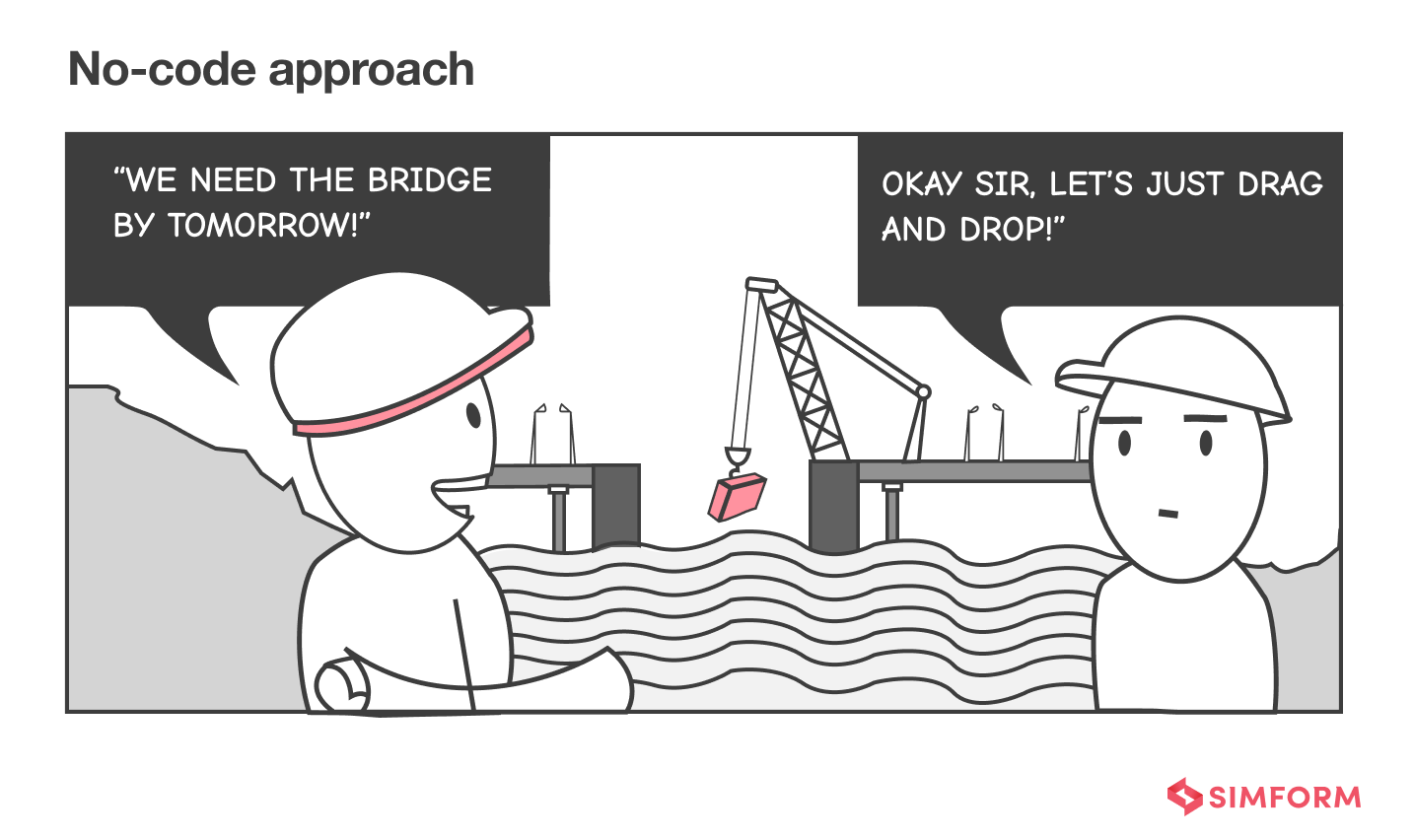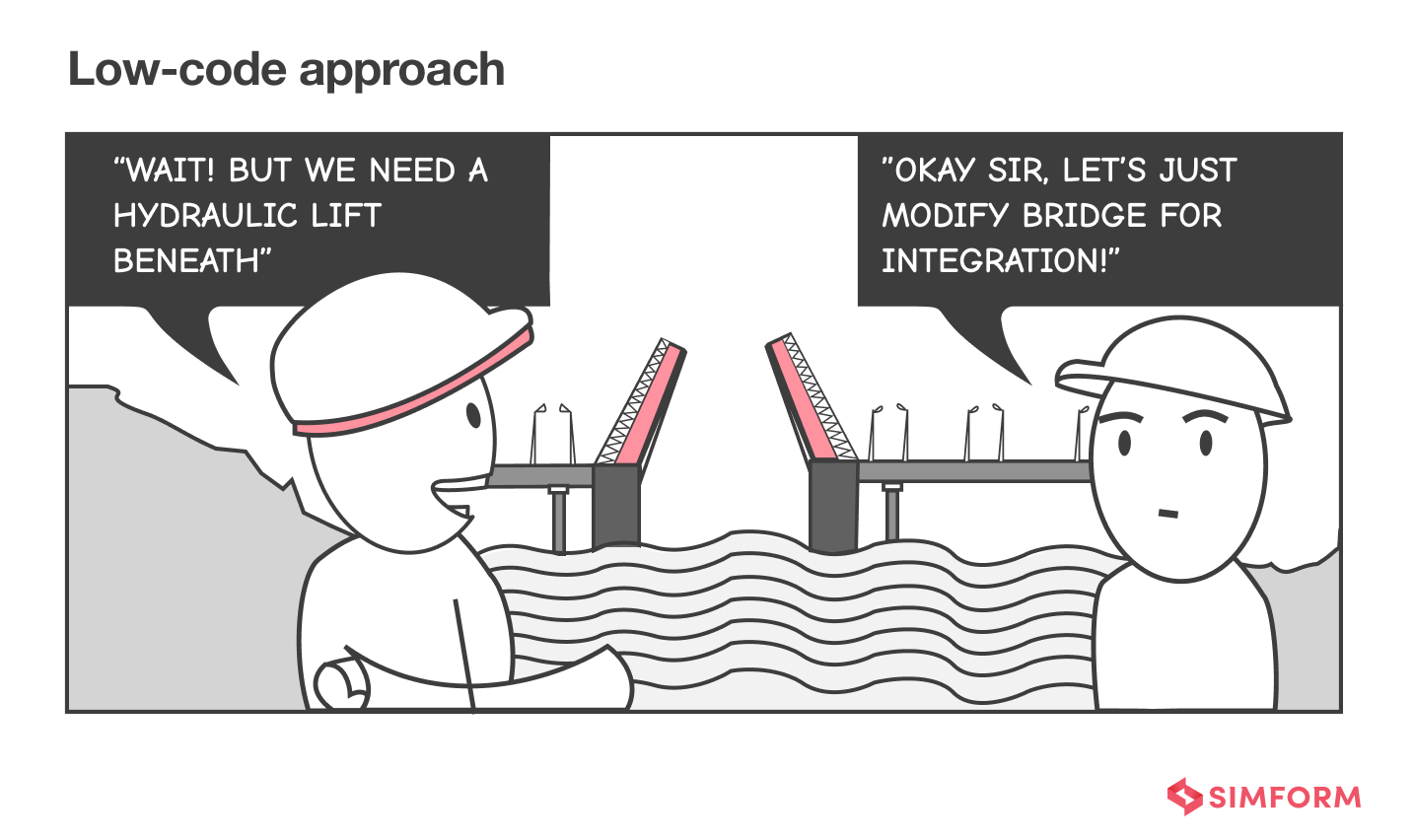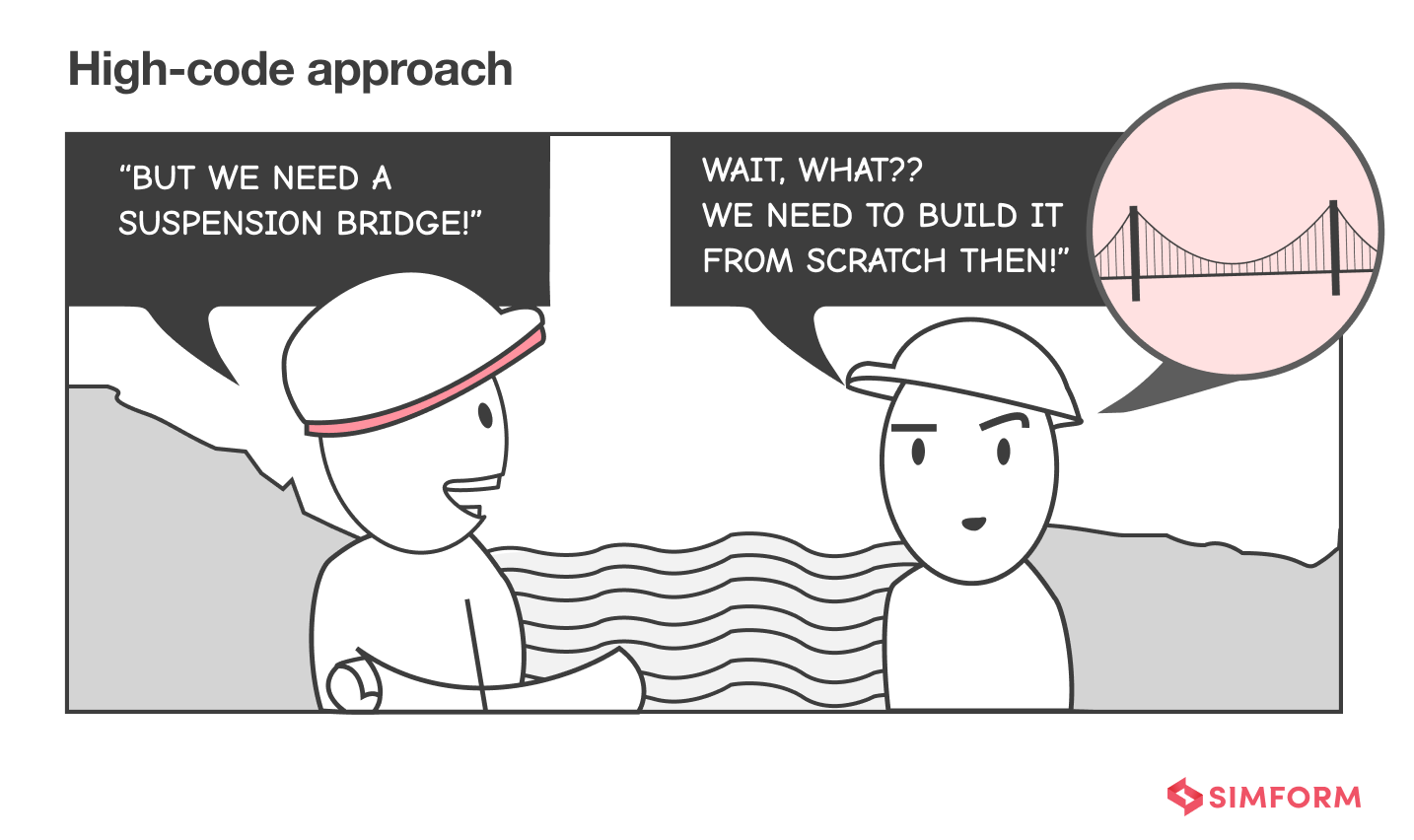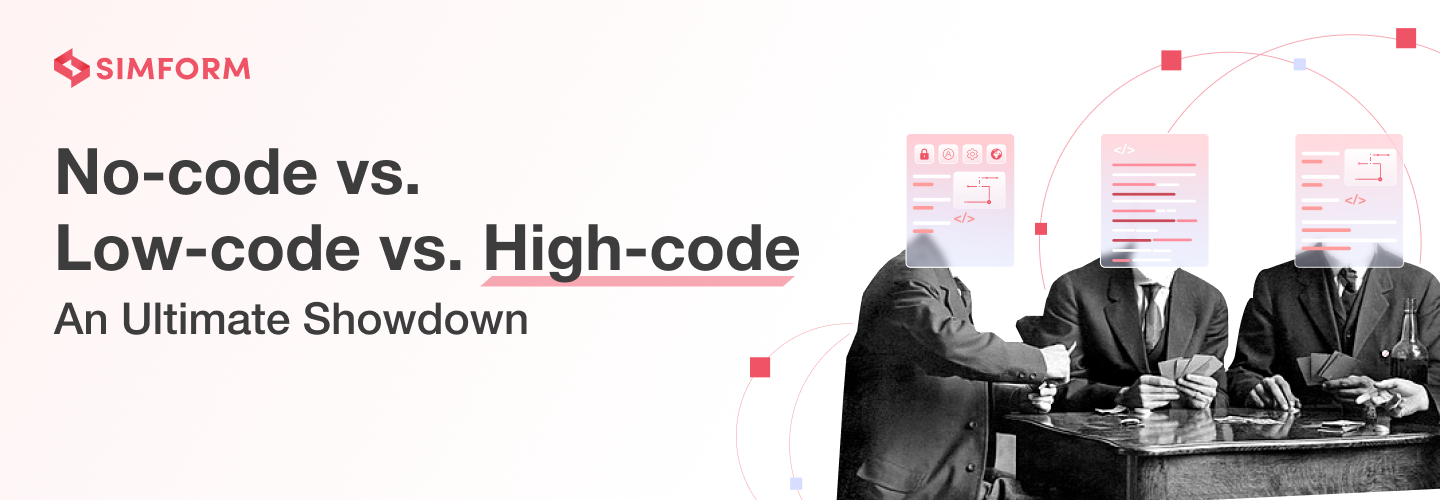No-code vs. Low-code vs. High-code: Which One to Choose?
Since Elon Musk announced chargeable Twitter accounts, many companies might consider bringing more options to the market. Suppose you were to create a Twitter alternative; what development approach would you choose – no-code, low-code, or high-code?
No-code and low-code platforms are called the new frontiers of rapid development as they help develop apps quickly without relying on the development team. However, they have limitations when it comes to customizations. So if you’re planning to develop a custom application like Twitter or a website like Amazon or any feature-rich application, you might have to stick to the old fashion high-code platform.
Though you may naturally think that high-code development takes longer, we need a comprehensive take on no-code vs. low-code vs. high-code. The reason is that you need to consider many factors before choosing a development platform, like development speed, customizations, extensibility, etc. So, here is a detailed comparison beginning with the overview.
No-code vs. Low-code vs. High-code: An overview
Organizations have relied on two significant development approaches for several decades. First is to hire developers, and second is to use an off-the-shelf product. However, no-code or low-code platforms offer a third alternative. Besides being a light coding approach, no-code and low-code have been helping citizen developers with development ease.
However, the highly opinionated approach makes no-code or low-code platforms a skeptical decision for some businesses. The high-code approach offers the flexibility of customization for enterprises making it an ideal choice for large-scale projects. Comparing the three methods is crucial before formulating the software development strategy.
First, let’s understand no-code, low-code, and high-code approaches!
What is no-code?

A no-code platform allows users to drag and drop modules and build applications. It is a visual approach that hides the complex code beneath modules. No-code tools use data abstraction and encapsulation to conceal the code complexity. So, users can use simple maneuvers to create applications.
What makes no-code platforms an attractive choice is the ease of development. It allows citizen developers and non-skilled professionals to develop applications without coding knowledge. They can simply drag and drop different pre-built blocks to create apps.
No-code does not mean there is no coding at all. Here, the coding part stays hidden. No-code development is the best choice if you have limited IT resources and lack technical skills.
Pros
- Minimal coding requirements make development easy
- Reduced IT resource needs make it attractive for startups
- Lego approach helps in building apps rapidly
- Reduced development costs as skilled developers are not required
- Making sudden changes in apps is accessible compared to manual coding
Cons
- Restricted development as the hidden source code for each block is immutable
- Limited support for low-level features like audio or video processing
- Lack of control over factors like price, security, and service quality
What is low-code?

Low-code development is a visual method with minimal coding requirements. It offers rapid app delivery through a graphical user interface with drag-and-drop features. Low-code platforms automate the development process and eliminate dependencies on conventional programming approaches.
The level of customization makes low-code development better than no-code with slightly more customization capabilities. Especially for seasoned developers who want to customize specific features and services in a large project, low-code platforms allow the creation of small-scale apps.
Low-code platforms provide visually integrated development environments, APIs, data connectors, and ready-made code templates to enable rapid development and a better focus on product development.
Pros
- Improved development speed with integrated visual development tools
- Parallel development is possible with minimum resource sharing
- Higher security with pre-built authentication and access management modules
- Easy rollback of changes to a stable version reduces operational disruptions
- Support for integration of services makes feature addition easier
Cons
- Complexity of business logic makes operational efficiency a challenge
- Restrictions on adding functions can be frustrating for businesses
- Need for technical expertise can be demanding compared to no-code platforms
- Security limitations compared to the conventional development approach are apparent
What is high-code?

High-code is the conventional approach of handwriting source code for your apps. Such an approach is a sort of assembly model which follows a code-driven experience. In other words, you create each aspect of your applications by hiring a team of developers. However, content and data are updated on demand using a headless CMS or API-based services.
The high-code approach is heavily developer reliant and yet offers better customization. Unlike no-code/low-code platforms, it does not have any restrictions on what kind of modules you can use to build apps.
Pros
- Streamlined procedures in a high-code development approach are easier to manage
- Less complexity with highly customizable code as per business requirements
- Higher developer focus means better developer capabilities and experience
- Better control of the source code behavior by developers
- High-end engineering prowess for each feature and customizations
- Enhanced agility with the flexibility of adding functions as per market demand
Cons
- Higher developer reliance leads to less focus on product innovations
- More development time as each code is hand-written
- Higher development costs as you need a team of developers
An overview of no-code, low-code, and high-code is not enough to determine which suits better to your project needs. So, let’s compare them and resolve the debate on the software development approach. Let’s start with no-code vs. low-code!
No-code vs. Low-code: Similarities and differences
No-code or low-code is similar in some aspects but different in many ways. Both approaches are touted as an alternative to conventional development methodologies where code is handwritten. Let’s first understand the similarities!
Similarities between no-code and low-code platforms
Both approaches have a visual interface at their core to reduce manual coding tasks. No-code or low-code platforms adopt a design-based workflow for the logical progression of information. Both share benefits like
- Dependency reduction and technology democratization
- Increased development velocity and time to market
- Enhanced prototyping to reduce risks
- Higher design and code consistency
- Cost-effective compared to conventional approaches
- Better collaboration among development and other teams
No-code vs. Low-code: how are both approaches different?
One of the fundamental differences between no-code and low-code platforms is openness. No-code platforms offer a closed system for development. So, when you make the changes in the source code in the no-code platform, it will not impact the work across use cases.
Low-code platforms, on the contrary, provide an open system that allows users to add code or changes that impact app operations. In other words, low-code platforms enable developers to make changes that affect how the code works and all the app use cases.
| Differentiators | No-code | Low-code |
| Target users | Tech-savvy domain experts with no coding knowledge | Professional developers who wants to reduce writing basic codes and work on complex features |
| Use cases | UI apps that pull data from sources to analyze, import or export key information | To integrate external APIs, build extended applications and connect systems with multiple data sources |
| Development speed | Faster than low-code due to drag and drop feature | Slower than no-code as it requires training and onboarding of developers |
| Open/closed system | No-code is a closed system and can only be extended through specific templates | Low-code offers an open system that allows developers to extend functionality via code. |
| Extensibility | No-code is not extensible | Low-code is more extensible than no-code |
No-code, and the low-code difference is significant but does it stand as an alternative to high-code? Let’s find out!
No-code/Low-code boom: Everything that glitters is not gold!
The advantages of faster development have led to a no-code boom. According to GlobeNewswire, the no-code/low-code platform market will grow at a CAGR of 28.8% and reach $159 billion in revenues by 2030. So, there is no denying that no-code/low-code is becoming popular.
However, what trumps the booming market is its inability to cope with market demands. Take an example of a digital auction platform. The auction company wanted a solution that could
- Enhance app release management
- Provide microservices cloud architecture
- Integrate systems at scale
- Embrace the DevOps culture
Imagine building such an auction platform on a no-code/low-code development tool. It does not provide the extensibility to integrate new services and cloud-based architecture. So, you need to leverage the traditional development approach.
The conventional approach involves a team of developers creating software from scratch. A professional product engineering service can help you build cloud-based applications which are scalable, flexible, and extensible.
So, if you are building an auction platform with several integrations and a DevOps culture, using the high-code approach makes more sense. However, deciding the development approach requires an analysis of how they differ in different factors affecting the business outcome.
So, let’s understand the advantages of the high-code on no-code/low-code approach and how they differ on different factors like time-to-market, efficiency, code maintenance, etc.
No-code vs. Low-code vs. High-code: Showdown of conventional and new age development
High-code assembly depends on skilled developers who write and deploy codes. At the same time, low-code platforms provide ready-made code templates making the process faster and easier.
The approach of high-code assembly is code-driven and supports any software or application. The low-code approach provides a visually driven development approach that offers simplicity for developers but has restrictions on creativity. Businesses choose high-code over low-code when they need enterprise-grade applications.
Advantages of high-code over low-code development
- Companies can add features and functionalities without any restrictions
- High-code provides freedom to choose any technology, hosting, API service, etc.
- In comparison to low-code, high-code provides ownership of the source code
- High-code offers better control on the development environment
- Custom app development requires streamlined processes which high-code offers
- High-code enables integration of CI/CD and adoption of DevOps culture
Knowing the advantages of high-code over no-code/low-code approach is not enough as you need a more decisive comparison.

| Comparison factors | No-code/Low-code | High-code |
| Need for coding | Minimum need for coding required | Developers need to code the apps from scratch |
| Time to market | Takes about 1-3 weeks to build an app | Requires 2-8 months to complete an app with hardcore coding |
| Customizations | Limited customizations | High-level customizations for custom app development |
| Business agility | Improves the speed of each release and allow you to develop new builds but has limited integrations to support new features | Allows companies to add new features, services and integrations according to market demand |
| Deployment | You can deploy low-code apps faster but on limited platforms. | Traditional app development allows companies to build web apps that work across platforms |
| Application quality | Due to live debugging, the apps can be error-free but with limited functionality | High-level code and app quality with agile practices where you improve with each iteration |
| Code maintenance | Due to minimal coding, maintenance is easy | It needs more effort to maintain code |
Each approach has specific use cases: no-code, low-code, or high-code. Understanding the use cases is crucial for companies to decide the most suitable development approach.
No-code vs. Low-code vs. High-code: Which one is ideal for your projects?
No-code/low-code platforms are useful if you want a shorter time-to-market and high-code is a better choice if you need better customizations. Each approach has its use cases. So, you can choose the most suitable approach based on the use case.
When to use no-code?
No-code platforms have many use cases, including the development of mobile applications, internal APIs, real-time data fetching services, etc. Here are some of the scenarios when you can use a no-code development approach:
- You want to develop a prototype of the product
- Your organization requires internal service APIs
- You want to develop apps to support business functions
- You are looking to develop single page website
- You need to develop apps with low-skilled talent
- You don’t have enough experience and IT resources
When to use low-code?
Low-code platforms provide code templates, features, and tools to create applications without manual coding. So, it is best for businesses looking to build apps rapidly. However, you have to compromise on the customization aspect a little bit.
- You are a startup looking to launch the app quickly]
- You need visual-driven development features for developers
- You have a team of skilled and semi-skilled developers
- You want to develop apps rapidly but with minimal customization
- You need an application for data integration
- Your organizations need to build external APIs
When to use high-code?
High-code development allows you to assemble handwritten codes and build highly customizable applications. Such an approach offers higher extensibility, flexibility, and developer focus on app development.
- Your organizations need enterprise-grade applications
- You want to add features and functionality to apps
- Your business functions require customizable apps
- You need highly scalable apps to handle peak loads
- Your organization requires apps with integrations like AI
- You want to develop eCommerce apps with advanced features
How Simform offers high-code excellence?
The battle of no-code vs. low-code vs. high-code comes down to three crucial aspects – agility, development velocity, and scalability. Simform enables rapid development with a high-code approach through agile practices.
We help clients build applications that are agile and easily scalable. Our digital engineering excellence has helped several clients achieve the best of high-code development over the years.
Simform’s engineers excel at microservice implementations with DevOps best practices to help clients get,
- Rapid development with high-quality code
- Better customization and ease of development
- Enhanced app performance and higher extensibility
- Microservices cloud-based architecture and flexibility
So, if you want to build enterprise-grade apps without compromising on speed or quality code, sign up for a 30-minute free session with our experts.




